
Different Types of ISO Containers
Other than the standard, general purpose container, many variations exist for use with different cargoes. The most prominent of these are refrigerated containers (a.k.a. reefers) for perishable goods, that make up six percent of the world's shipping boxes.[3][40] And tanks in a frame, for bulk liquids, account for another 0.75% of the global container fleet.[3]
Although these variations are not of the standard type, they mostly are ISO standard containers – in fact the ISO 6346 standard classifies a broad spectrum of container types in great detail. Aside from different size options, the most important container types are:[52][nb 11]
- General-purpose dry vans, for boxes, cartons, cases, sacks, bales, pallets, drums, etc., Special interior layouts are known, such as:
- Ventilated containers. Essentially dry vans, but either passively or actively ventilated. For instance for organic products requiring ventilation
- Temperature controlled – either insulated, refrigerated, and/or heated containers, for perishable goods
- Tank containers, for liquids, gases, or powders. Frequently these are dangerous goods, and in the case of gases one shipping unit may contain multiple gas bottles
- Bulk containers (sometimes bulktainers), either closed models with roof-lids, or hard or soft open-top units for top loading, for instance for bulk minerals. Containerized coal carriers and "bin-liners" (containers designed for the efficient road and rail transportation of rubbish from cities to recycling and dump sites) are used in Europe.
- Open-top and open-side containers, for instance for easy loading of heavy machinery or oversize pallets. Crane systems can be used to load and unload crates without having to disassemble the container itself.[56] Open sides are also used for ventilating hardy perishables like apples or potatoes.
- Platform based containers such as:
- flat-rack and bolster containers, for barrels, drums, crates, and any heavy or bulky out-of-gauge cargo, like machinery, semi-finished goods or processed timber. Empty flat-racks can either be stacked or shipped sideways in another ISO container
- collapsible containers, ranging from flushfolding flat-racks to fully closed ISO and CSC certified units with roof and walls when erected.[57]
Containers for Offshore use have a few different features, like pad eyes, and must meet additional strength and design requirements, standards and certification, such as the DNV2.7-1 by Det Norske Veritas and the European standard EN12079: Offshore Containers and Associated Lifting Sets.[58]
A multitude of equipment, such as generators, has been installed in containers of different types to simplify logistics.
Swap body units usually have the same bottom corner fixtures as intermodal containers, and often have folding legs under their frame so that they can be moved between trucks without using a crane. However they frequently don't have the upper corner fittings of ISO containers, and are not stackable, nor can they be lifted and handled by the usual equipment like reach-stackers or straddle-carriers. They are generally more expensive to procure.
Reference: https://en.wikipedia.org/wiki/Intermodal_container
Flat racks and platforms are ISO containers that are used to transport heavy machinery. They do not have side walls, but may have end bulkheads and are often collapsible.
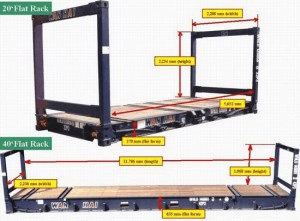
Open-top containers are shaped like a box and loaded from either the top or end. They are designed to carry heavy, tall, or hard to load materials such as coal or grain.
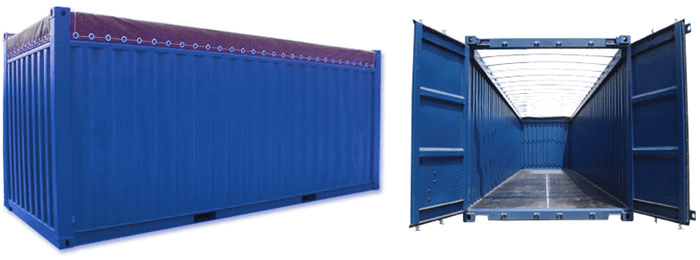
Dry freight or cube containers are front loaded, completely enclosed and suitable for general-purpose transportation.
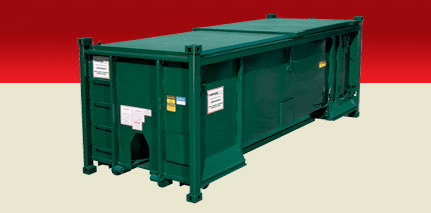
Insulated or thermal containers are suitable for transporting chilled and frozen goods, as well as temperature-sensitive materials and products. They have insulated walls, but are not refrigerated.
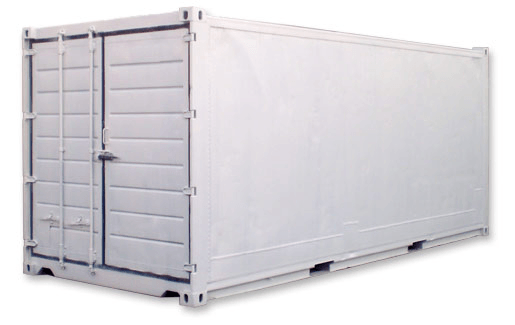
Reefer or refrigeration containers are temperature controlled containers that have an integral refrigeration unit. They are used to ship and transport perishables or other items that require a temperature controlled atmosphere.
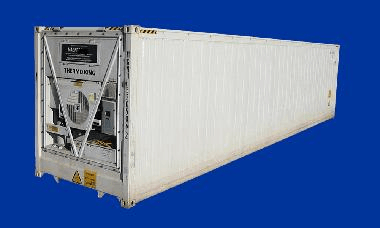
Tank containers are built to the same standard dimensions as other ISO containers, but are cylindrical vessels mounted in a rectangular steel framework. Typically, these containers are used to transport liquid or bulk materials.
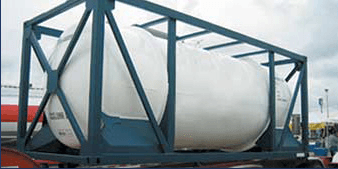
Non-Standard and Uncommon Sizes
Pallet wide containers
Pallet Wide containers have about 4 inches (10.2 cm) more internal floor width than standard containers to accommodate more Euro-pallets, common in Europe.[63] These containers typically have an internal width of 2.44 m (96 1⁄8 in), to be able to load either two or three of the 1.2 m (47 1⁄4 in) long by 0.8 m (31 1⁄2 in) wide pallets side by side. Many sea shipping providers in Europe allow these, as overhangs on standard containers are sufficient and they fit in the usual interlock spaces (or with the same floor panel the side ribs of pallet-wide containers are embossed to the outside instead of being molded to the inside).[64]
The 45 ft (13.72 m) pallet-wide high-cube container has gained particularly wide acceptance, as these containers can replace the 13.6 m (44 ft 7 3⁄8 in) swap bodies that are common for truck transport in Europe. The EU has started a standardization for pallet wide containerization in the European Intermodal Loading Unit (EILU) initiative.[65]
Australian RACE containers are also slightly wider to optimise them for the use of Australia Standard Pallets.
48-foot containers
The 48-foot (14.63 m) shipping container is a High Cube container in that it is 9 ft 6 in (2.90 m) tall on the exterior. It is 8 ft 6 in (2.59 m) wide which makes it 6 inches (15 cm) wider than ISO-standard containers.[66] This size was introduced by container shipping company APL in 1986, and is used domestically in North America on road and rail,[67] and may be transported on deck by ship. This size being 8 feet (2.44 m) longer and 6 inches (15 cm) wider has 29% more volume capacity than the standard 40-ft High Cube,[68] yet costs of moving it by truck or rail are almost the same.
53-foot containers
General purpose 53-foot (16.15 m) containers were introduced in the United States in 1989, and are used both in the US and Canada, mainly for domestic road and rail transport.[67] They are considered High-cubes, based on their 9 ft 6 in (2.90 m) ISO-standard height. Their width of 8 ft 6 in (2.59 m) however makes them 6 inches (15 cm) wider than ISO-standard containers.[66] These large boxes have 60% more capacity than standard-height 40-foot (12.19 m) containers, enabling shippers to consolidate more cargo into fewer containers.[68][69][70]
Generally, North American 53-foot containers were not constructed strong enough to endure the rigors of ocean transport, but in 2007 container carrier APL introduced the first 53-foot ocean-capable containers. All new, reinforced 53-foot boxes were built specifically for international trade and designed to withstand ocean voyages on its South China-to-Los Angeles service.[67] In 2013 however, APL stopped offering vessel space for 53-foot containers on its trans-Pacific ships.[71] Nevertheless, In 2015 both Crowley and TOTE Maritime each announced the construction of their respective second combined container and roll-on/roll-off ships for Puerto Rico trade, with the specific design to maximize cubic cargo capacity by carrying 53-foot, 102-inch wide (2,591 mm) containers.[72] [73] Within Canada, Oceanex offers 53-foot-container ocean service to and from the island of Newfoundland.[74] Fifty-three-foot containers are also being used on some Asia Pacific international shipping routes.[60]
60-foot containers
In May 2017, Canadian Tire and Canadian Pacific Railway announced deployment of the first 60-foot (18.29 m) intermodal containers in North America. The containers allow Canadian Tire to increase the volume of goods shipped per container by 13%.[75]
Small containers
The United States military continues to use small containers, strongly reminiscent of their Transporter and Conex boxes of the 1950s and 1960s. These either comply with ISO standard dimensions, or are a direct derivative thereof. Current terminology of the United States armed forces calls these small containers Bicon, Tricon and Quadcon, which correspond with ISO 668 standard sizes 1D, 1E and 1F respectively. This comes down to containers of 8 ft (2.44 m) height, and with a footprint size either one half (Bicon), one third (Tricon) or one quarter (Quadcon) the size of a standard 20-foot, one TEU container.[76][77][78]
At a nominal length of 10 feet (3 m), two Bicons coupled together lengthwise match one 20-foot ISO container, but their height is 6 inches (152 mm) shy of the more commonly available 10-foot ISO containers of so-called standard height, which are 8 ft 6 in (2.59 m) tall. Tricons and Quadcons however have to be coupled transversely — either three or four in a row — to be stackable with twenty foot containers.[79] Their length of 8 ft (2.44 m) corresponds to the width of a standard 20-foot container, which is why there are forklift pockets at their ends, as well as in the sides of these boxes, and the doors only have one locking bar each. The smallest of these, the Quadcon, exists in two heights: 96 in (2.44 m) or 82 in (2.08 m).[80] Only the first conforms to ISO-668 standard dimensions (size 1F).
Reference: https://en.wikipedia.org/wiki/Intermodal_container

